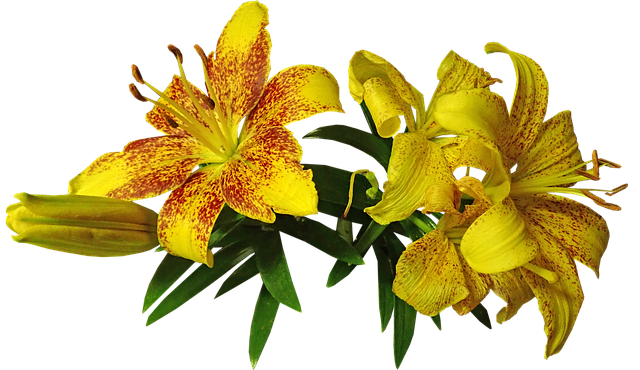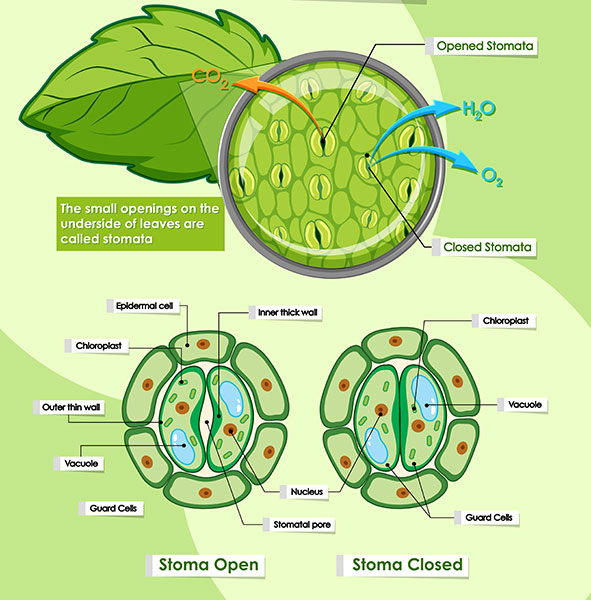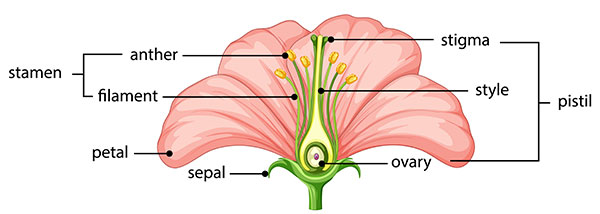UNDERSTANDING BOTANY BASICS
If you’re interested in plants and how they work, then understanding botany basics is a great place to start.
Botany is the scientific study of plants, from their physical structure and chemical processes to their evolution and ecological relationships. It’s a fascinating and complex field that encompasses everything from algae and mosses to ferns, flowers, and trees.
At its core, botany is concerned with understanding how plants function and interact with their environment. This includes everything from the way they photosynthesize and reproduce to the role they play in the food chain and their impact on the atmosphere and climate.

Plant nomenclature
Plant nomenclature is the system of naming plants according to a set of rules and conventions established by the International Code of Nomenclature for algae, fungi, and plants (ICN). This system is used to assign a unique scientific name to each plant species, allowing scientists and other plant enthusiasts to communicate about plants with precision and accuracy.
Plant nomenclature follows a standardized format that includes two parts: the genus and the species. The genus refers to a group of related plants that share similar characteristics, while the species is a unique identifier that distinguishes one type of plant from another within that genus.
The scientific names of plants are typically written in Latin or Latinized forms of words, which allows them to be universally recognized and understood by scientists and botanists around the world. In addition, plant nomenclature also includes a set of rules for creating new plant names, resolving conflicts between names, and updating names as new information becomes available.
Some examples:
Acer saccharum (Sugar maple), Pinus sylvestris (Scots pine), Lavandula angustifolia (English lavender)
In each of these examples, the genus and species names are written in italics, with the genus name capitalized and the species name in lowercase. This standardized format allows scientists to refer to a particular plant species accurately and unambiguously.
Plant vascular system
The vascular system of plants is made up of two main types of tissues: xylem and phloem. Xylem tissue transports water and minerals from the roots to the leaves, while phloem tissue carries sugars and other organic molecules from the leaves to other parts of the plant.
Xylem – The xylem is a specialized tissue that is responsible for the transportation of water and minerals from the roots to the other parts of the plant, such as the stems and leaves. The xylem tissue consists of long, hollow cells called tracheids and vessel elements, which are connected end-to-end to form a continuous pathway for water transport.
In woody plants, sapwood is the younger, outermost layer of xylem tissue that is responsible for transporting water and minerals from the roots to the leaves of the plant. It contains living cells that are actively involved in the process of water transport and is typically lighter in color than heartwood.
Heartwood, on the other hand, is the older, innermost layer of xylem tissue that no longer transports water and minerals. It is typically darker in color than sapwood and contains dead cells that are filled with resins, tannins, and other compounds that give it its characteristic color and hardness. Heartwood serves primarily as a structural support for the tree, helping it to withstand the forces of wind and gravity.
Phloem – The phloem is specialized tissue that is responsible for the transportation of organic molecules, such as sugars, amino acids, and hormones, from the leaves and other photosynthetic tissues to the non-photosynthetic tissues of the plant. Unlike the xylem, which only transports water and minerals, the phloem moves both organic and inorganic molecules throughout the plant.
The cambium – The thin cambium is critical to tree health. This meristem is the origin of all phloem and xylem material. If the cambium is destroyed, the plant will die.

Tree trunk cross section
Image: Freepik
Plant meristems
Meristems are specialized regions of plant tissue where cell division and differentiation take place, leading to the growth and development of the plant. They are located at the tips of the roots and shoots, as well as in other regions of the plant such as the cambium and the cork cambium. There are two main types of meristems: apical meristems and lateral meristems.
Apical meristems are located at the tips of the roots and shoots and are responsible for primary growth, which is the growth in length of the plant. The apical meristem of the root produces new cells that differentiate into the various types of root tissues, while the apical meristem of the shoot produces new cells that differentiate into the stem, leaves, and flowers.
Lateral meristems are responsible for secondary growth, which is the growth in girth or width of the plant. The two main lateral meristems are the vascular cambium and the cork cambium. The vascular cambium produces new xylem and phloem tissues, allowing the plant to grow thicker over time. The cork cambium produces cork cells, which form the protective outer layer of the plant, helping to prevent water loss and protect against external damage.
Meristems are important for plant growth and development, as they allow the plant to continuously produce new cells and tissues throughout its life cycle. Understanding the biology of meristems has contributed to advancements in agriculture and horticulture, as it allows for the manipulation of plant growth and development to improve crop yield and quality.
Roots – anatomy
Roots are responsible for anchoring the plant to the soil, absorbing water and minerals, and storing nutrients. Root anatomy refers to the different tissues and structures that make up the root.
The outermost layer of the root is the epidermis, which is responsible for absorbing water and minerals from the soil. The epidermis contains root hairs, which are small, finger-like projections that increase the surface area of the root and facilitate absorption.
Beneath the epidermis is the cortex, which is composed of parenchyma cells that store starch and other nutrients. The cortex also contains endodermis, a layer of cells that regulates the flow of water and nutrients into the vascular tissues of the root.
The vascular tissue of the root is composed of xylem and phloem, which are responsible for transporting water, minerals, and organic molecules throughout the plant. The xylem tissue is located at the center of the root and is responsible for transporting water and minerals from the roots to the leaves of the plant. The phloem tissue is located on the outside of the xylem and is responsible for transporting organic molecules, such as sugars and amino acids, from the leaves to the rest of the plant.
In some plants, the root also contains a pericycle, which is a layer of cells located between the endodermis and the vascular tissue. The pericycle is responsible for producing lateral roots, which allow the plant to expand its root system and absorb more water and nutrients from the soil.

Internal root structure
Image by brgfx on Freepik
The function of leaves
The main function of leaves is to carry out photosynthesis, the process by which plants produce glucose and oxygen using energy from the sun. In addition to photosynthesis, leaves also perform the following functions:
Gas exchange: Leaves contain small pores called stomata, which allow for the exchange of gases, such as carbon dioxide and oxygen, between the plant and the environment. This process is crucial for the plant’s survival as it allows them to take in carbon dioxide for photosynthesis and release oxygen.
Transpiration: Leaves also play a role in transpiration, which is the loss of water from the plant through evaporation. Transpiration helps to regulate the plant’s temperature and maintain water balance in the plant.
Storage: Some leaves are modified to store food, water, and other nutrients. For example, succulent leaves store water, while bulbs and corms store nutrients.
Protection: Leaves can also serve a protective function by producing chemicals that repel herbivores or deter fungal and bacterial infections.
Sensory function: Some leaves contain specialized cells that can detect light, touch, and other environmental cues.

Leaf Stomata
Image by brgfx on Freepik
Flower – anatomy
Flowers are the reproductive structures of plants, and their anatomy is designed to facilitate the transfer of pollen between plants or within the same plant. The basic structure of a flower can be divided into four main parts:
Sepals: The sepals are the outermost part of the flower, and they protect the developing bud before it opens. They are usually green, and their arrangement is known as the calyx.
Petals: The petals are usually the most conspicuous part of the flower and are responsible for attracting pollinators, such as bees and butterflies. They are often brightly colored and arranged in a circular pattern known as the corolla.
Stamens: The stamens are the male reproductive structures of the flower and are composed of anthers and filaments. The anthers produce pollen, which contains the male gametes that will fertilize the female gametes.
Pistil: The pistil is the female reproductive structure of the flower and is composed of the stigma, style, and ovary. The stigma is the sticky part of the pistil that receives the pollen, the style is the tube-like structure that connects the stigma to the ovary, and the ovary contains the female gametes.
In addition to these four main parts, flowers may also have accessory structures such as nectaries, which produce nectar to attract pollinators, or spurs, which are elongated structures that provide a platform for pollinators to land on.
The arrangement and shapes of these structures can vary widely between different types of flowers, depending on the specific pollination strategy they have evolved to use.

Flower Anatomy
Image by brgfx on Freepik
Plant hormones
Auxin: Auxin is a crucial plant hormone that plays a vital role in plant growth and development. It promotes cell elongation, root formation, and the development of new shoots. Auxin also helps regulate phototropism, which is the bending of plant stems and leaves in response to light. Additionally, auxin is involved in apical dominance, where the top of the plant dominates growth over the lower parts.
Gibberellins: Gibberellins control plant growth and development. They promote stem elongation, seed germination, and the development of fruits and flowers. Gibberellins also play a role in regulating the size and shape of leaves and stems.
Cytokinins: Cytokinins promote cell division and differentiation. They also regulate the growth of lateral buds and promote the development of chloroplasts. Cytokinins are important in the regulation of plant growth and development, particularly in balancing cell division and cell differentiation.
Abscisic Acid (ABA): Abscisic acid regulates seed dormancy, stomatal closure, and the response to environmental stresses such as drought and high salinity. ABA also plays a role in the regulation of plant growth, particularly in response to environmental changes.
Ethylene: Ethylene promotes fruit ripening, leaf senescence, and the response to environmental stresses such as flooding and drought. Ethylene is also involved in the regulation of plant growth and development, particularly in response to light and other environmental cues.
Auxins and gibberellins are produced in apical meristems – with careful pruning, you can train plants to grow in specific ways by controlling these hormones. For example, if you inhibit gibberellins, you can encourage dwarfing plant habits.
Tying it all together – How an understanding of botany basics can help you become a better gardener
A basic understanding of plant botany can encourage good gardening habits by providing insights into how plants grow, develop, and interact with their environment.
For example, knowing the preferred growing conditions of a particular plant, such as its light, water, and soil requirements, can help ensure that the plant thrives in the garden.
Understanding plant anatomy, such as the structure of roots, stems, and leaves, can also inform how plants should be pruned or trained to promote healthy growth.
Additionally, knowing about the life cycle of plants can help gardeners plan for succession planting and crop rotation to maintain soil health and reduce pest and disease pressure. Overall, a basic understanding of plant botany empowers gardeners to make informed decisions about plant care, leading to healthier plants, higher yields, and a more productive garden.
